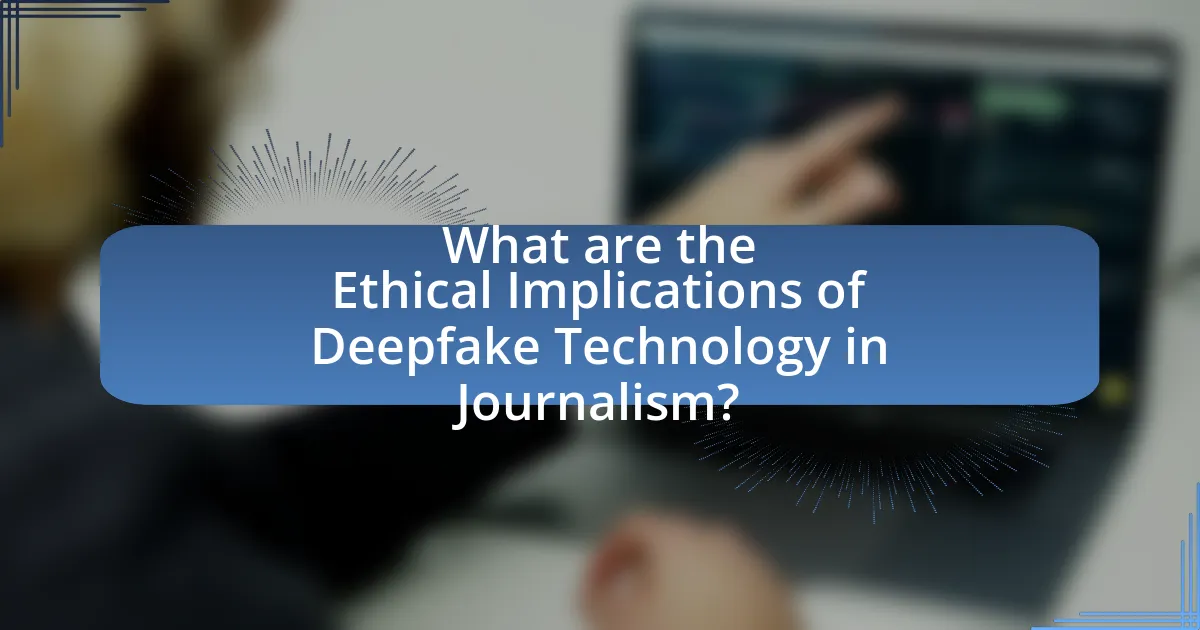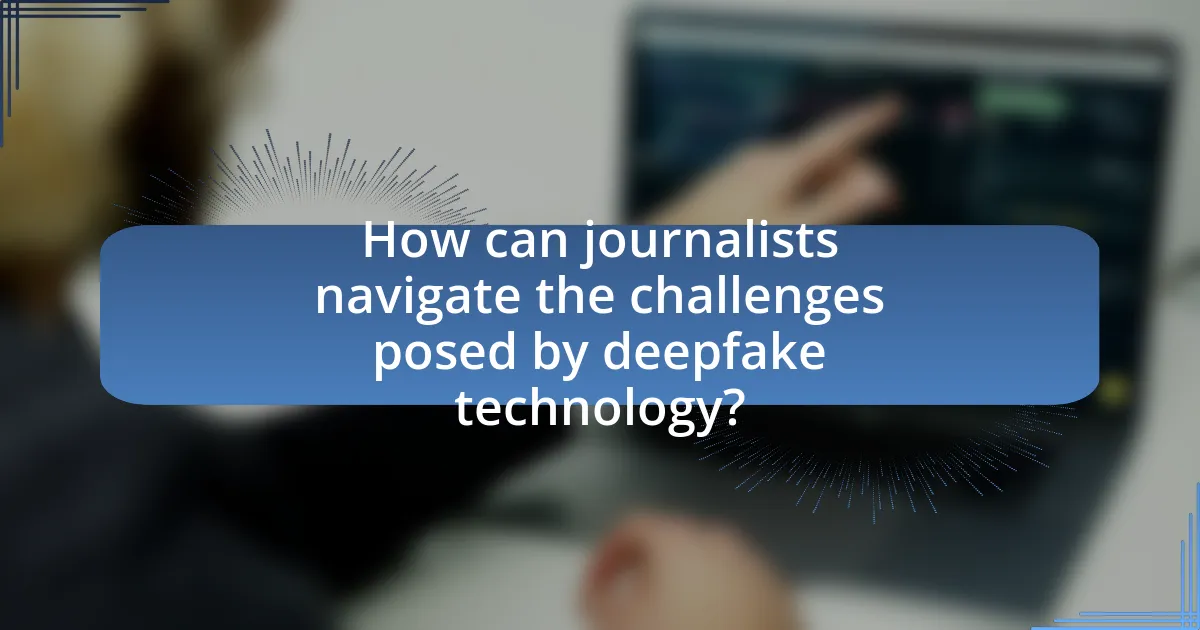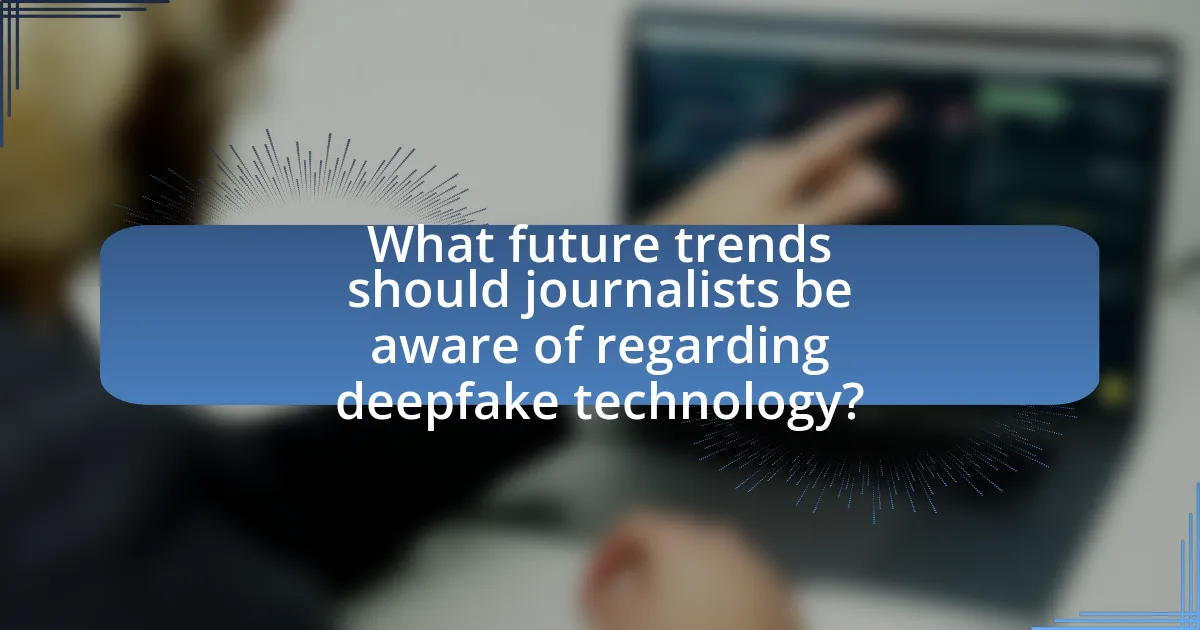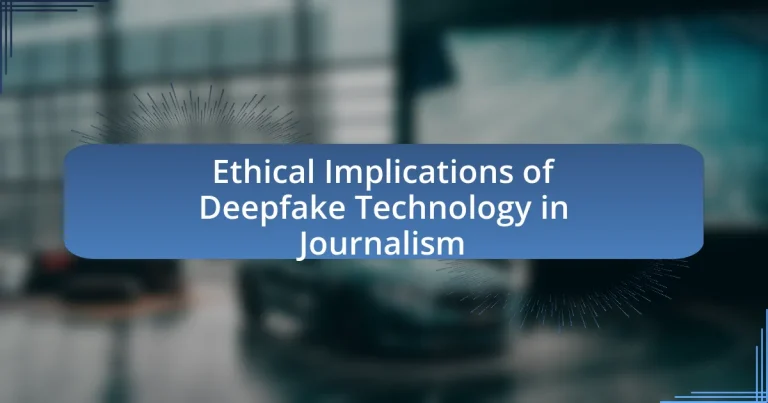The article examines the ethical implications of deepfake technology in journalism, highlighting concerns about misinformation, erosion of public trust, and challenges to accountability. It discusses how deepfakes can undermine journalistic integrity by creating realistic but false representations, leading to the spread of false narratives and skepticism towards legitimate news sources. The article also addresses the responsibilities of journalists in verifying content authenticity, the legal considerations surrounding deepfakes, and the need for ethical guidelines to navigate the challenges posed by this technology. Additionally, it explores strategies for journalists to enhance verification processes and maintain public trust in an evolving media landscape.

What are the Ethical Implications of Deepfake Technology in Journalism?
The ethical implications of deepfake technology in journalism include the potential for misinformation, erosion of trust, and challenges to accountability. Misinformation arises as deepfakes can create realistic but false representations of individuals, leading to the spread of false narratives. A study by the University of California, Berkeley, highlights that 85% of respondents expressed concern about the impact of deepfakes on public trust in media. Additionally, the ability to manipulate video content raises questions about the accountability of journalists and media organizations, as they must navigate the fine line between innovation and ethical responsibility.
How does deepfake technology impact journalistic integrity?
Deepfake technology undermines journalistic integrity by enabling the creation of highly realistic but fabricated audio and video content that can mislead audiences. This manipulation of media can lead to the dissemination of false information, eroding trust in news organizations and their reporting. A study by the University of California, Berkeley, found that 85% of respondents expressed concern about the potential for deepfakes to misinform the public, highlighting the significant threat to the credibility of journalism. As deepfake technology becomes more accessible, the challenge for journalists is to verify the authenticity of content, which is crucial for maintaining ethical standards in reporting.
What are the potential risks of misinformation in journalism due to deepfakes?
The potential risks of misinformation in journalism due to deepfakes include the erosion of public trust, the spread of false narratives, and the undermining of factual reporting. Deepfakes can create highly convincing but fabricated audio and video content that misrepresents individuals, leading audiences to believe in false events or statements. For instance, a study by the University of California, Berkeley, found that deepfake videos can significantly influence viewers’ perceptions, making them more likely to accept false information as truth. This manipulation can result in real-world consequences, such as inciting violence or swaying public opinion during elections, thereby posing a serious threat to the integrity of journalism and democratic processes.
How can deepfakes undermine public trust in media?
Deepfakes can undermine public trust in media by creating realistic but fabricated content that misleads audiences. This technology allows for the manipulation of video and audio, making it difficult for viewers to discern what is genuine. A study by the Massachusetts Institute of Technology found that 85% of participants could not identify deepfake videos, highlighting the potential for misinformation to spread rapidly. As a result, the credibility of legitimate news sources is compromised, leading to skepticism and doubt among the public regarding the authenticity of media content.
What ethical dilemmas arise from the use of deepfakes in news reporting?
The use of deepfakes in news reporting raises significant ethical dilemmas, primarily concerning misinformation, trust erosion, and the potential for manipulation. Misinformation arises when deepfakes are used to create false narratives or misrepresent facts, leading to public confusion and misinterpretation of events. Trust erosion occurs as audiences may become skeptical of legitimate news sources, questioning the authenticity of all media content due to the prevalence of deepfakes. Furthermore, manipulation can occur when individuals or organizations exploit deepfake technology to advance specific agendas, potentially harming reputations and influencing public opinion in unethical ways. These dilemmas highlight the urgent need for ethical guidelines and regulatory frameworks in journalism to address the challenges posed by deepfake technology.
How do deepfakes challenge the concept of truth in journalism?
Deepfakes challenge the concept of truth in journalism by creating highly realistic but fabricated audio and video content that can mislead audiences. This technology undermines the credibility of authentic news sources, as it becomes increasingly difficult for journalists and consumers to discern fact from fiction. For instance, a study by the University of California, Berkeley, found that deepfake videos can significantly alter viewers’ perceptions of reality, leading to misinformation and erosion of trust in media outlets. As deepfakes proliferate, they pose a significant threat to the integrity of journalistic standards and the public’s ability to access truthful information.
What responsibilities do journalists have when dealing with deepfake content?
Journalists have the responsibility to verify the authenticity of deepfake content before dissemination. This includes conducting thorough fact-checking and utilizing technology to detect manipulated media, as deepfakes can mislead audiences and damage reputations. According to a 2020 report by the Brookings Institution, deepfakes pose significant risks to public trust in media, emphasizing the need for journalists to uphold ethical standards by ensuring accuracy and transparency in their reporting.
What are the legal considerations surrounding deepfake technology in journalism?
The legal considerations surrounding deepfake technology in journalism include issues of defamation, copyright infringement, and privacy rights. Deepfakes can potentially misrepresent individuals, leading to false narratives that may harm reputations, which can result in defamation lawsuits. Additionally, the use of copyrighted material in creating deepfakes may violate intellectual property laws, exposing journalists to legal action. Privacy rights are also at stake, as individuals may not consent to their likeness being used in manipulated content, which can lead to legal repercussions under privacy laws. These considerations highlight the need for journalists to navigate the legal landscape carefully when utilizing deepfake technology.
How do current laws address the use of deepfakes in media?
Current laws address the use of deepfakes in media primarily through regulations related to fraud, defamation, and copyright infringement. For instance, several states in the U.S. have enacted specific legislation targeting deepfakes, such as California’s law that prohibits the use of deepfakes to harm or defraud individuals, particularly in the context of elections and pornography. Additionally, the federal government has considered measures to combat malicious deepfake technology, emphasizing the potential for misinformation and its impact on public trust. These legal frameworks aim to mitigate the risks associated with deepfakes while balancing free speech rights, reflecting ongoing concerns about the ethical implications of deepfake technology in journalism.
What legal precedents exist regarding deepfake-related defamation cases?
Legal precedents regarding deepfake-related defamation cases are still emerging, as the technology is relatively new and existing laws are being tested in courts. Notably, the case of “Doe v. Google” in 2020 highlighted the potential for deepfakes to cause reputational harm, where the court recognized the need for legal frameworks to address the unique challenges posed by manipulated media. Additionally, the California law enacted in 2018, which criminalizes the use of deepfakes for malicious purposes, sets a precedent for holding individuals accountable for defamation through this technology. These cases and laws indicate a growing recognition of the legal implications of deepfakes in defamation contexts.

How can journalists navigate the challenges posed by deepfake technology?
Journalists can navigate the challenges posed by deepfake technology by implementing rigorous verification processes and utilizing advanced detection tools. These measures are essential as deepfakes can undermine trust in media; for instance, a 2020 report from the Deepfake Detection Challenge highlighted that over 96% of deepfake videos went undetected by conventional methods. By adopting technologies such as AI-based detection software and cross-referencing information with credible sources, journalists can enhance their ability to identify manipulated content. Furthermore, ongoing education about the evolving nature of deepfake technology equips journalists with the knowledge necessary to discern authenticity in media, thereby maintaining journalistic integrity and public trust.
What strategies can journalists employ to verify content authenticity?
Journalists can employ several strategies to verify content authenticity, including cross-referencing sources, utilizing fact-checking tools, and analyzing metadata. Cross-referencing involves comparing information from multiple credible sources to confirm accuracy, which is essential in an era where misinformation can spread rapidly. Fact-checking tools, such as Snopes or FactCheck.org, provide resources to validate claims and debunk false narratives. Additionally, analyzing metadata, such as timestamps and geolocation data, can help determine the origin and context of digital content, further ensuring its authenticity. These strategies are critical in maintaining journalistic integrity, especially in the context of deepfake technology, which poses significant challenges to content verification.
What tools are available for detecting deepfakes in news media?
Tools available for detecting deepfakes in news media include Deepware Scanner, Sensity AI, and Microsoft Video Authenticator. Deepware Scanner analyzes videos for signs of manipulation, while Sensity AI employs machine learning algorithms to identify altered content. Microsoft Video Authenticator assesses images and videos to determine their authenticity by providing a confidence score regarding potential deepfake characteristics. These tools utilize advanced technology to enhance the reliability of news media by identifying deceptive content effectively.
How can collaboration with tech experts enhance verification processes?
Collaboration with tech experts can significantly enhance verification processes by integrating advanced technologies such as artificial intelligence and machine learning. These technologies enable the rapid analysis of content, identifying inconsistencies and potential deepfake elements more effectively than traditional methods. For instance, AI algorithms can analyze video and audio data for signs of manipulation, improving the accuracy of verification efforts. A study by the University of California, Berkeley, demonstrated that AI-driven tools could detect deepfakes with over 90% accuracy, showcasing the effectiveness of tech collaboration in enhancing verification processes.
What ethical guidelines should journalists follow when reporting on deepfakes?
Journalists should adhere to guidelines that prioritize accuracy, transparency, and accountability when reporting on deepfakes. Accuracy requires journalists to verify the authenticity of content before dissemination, as deepfakes can easily mislead audiences. Transparency involves clearly labeling deepfake content and informing audiences about its nature, which helps maintain trust. Accountability mandates that journalists take responsibility for the information they share, including correcting any misinformation related to deepfakes. These guidelines are essential to uphold journalistic integrity and protect the public from potential harm caused by misleading information.
How can journalists balance sensationalism and responsible reporting?
Journalists can balance sensationalism and responsible reporting by adhering to ethical guidelines that prioritize accuracy and context over dramatic presentation. Responsible reporting involves verifying facts, providing balanced perspectives, and avoiding exaggeration, which helps maintain credibility and public trust. For instance, the Society of Professional Journalists emphasizes the importance of minimizing harm and acting independently, which can counteract the allure of sensationalism. By focusing on thorough research and ethical standards, journalists can deliver compelling stories without sacrificing integrity.
What role does transparency play in reporting deepfake-related stories?
Transparency is crucial in reporting deepfake-related stories as it fosters trust and accountability among audiences. By clearly disclosing the methods used to identify and analyze deepfakes, journalists can enhance the credibility of their reporting. For instance, a study by the Pew Research Center found that 86% of Americans believe that transparency about sources and methods is essential for trustworthy news. This level of transparency helps mitigate misinformation and allows audiences to critically assess the validity of the content, ultimately promoting informed public discourse.

What future trends should journalists be aware of regarding deepfake technology?
Journalists should be aware that deepfake technology is evolving rapidly, leading to increased sophistication in the creation of realistic fake content. This trend poses significant challenges for verifying the authenticity of multimedia information, as advancements in artificial intelligence make it easier to produce convincing deepfakes that can mislead audiences. For instance, a study by the University of California, Berkeley, found that deepfake detection tools are struggling to keep pace with the rapid improvements in deepfake generation, highlighting the need for journalists to adopt advanced verification techniques and tools. Additionally, as deepfake technology becomes more accessible, the potential for its misuse in disinformation campaigns is likely to rise, necessitating a proactive approach from journalists to educate themselves and their audiences about the implications of this technology.
How might advancements in deepfake technology affect journalism?
Advancements in deepfake technology may significantly undermine the credibility of journalism by enabling the creation of highly realistic but fabricated audio and video content. As deepfake tools become more accessible and sophisticated, journalists may face challenges in verifying the authenticity of sources and materials, leading to potential misinformation and erosion of public trust. A study by the University of California, Berkeley, highlights that 96% of respondents expressed concern about the impact of deepfakes on news credibility, indicating a widespread recognition of the threat posed to journalistic integrity.
What emerging technologies could complement or counteract deepfakes?
Emerging technologies that could counteract deepfakes include blockchain for content verification and AI-based detection tools. Blockchain technology can provide a secure and immutable record of content creation, ensuring authenticity by tracing the origin of videos and images. AI-based detection tools, such as those developed by researchers at the University of California, Berkeley, utilize machine learning algorithms to identify inconsistencies in deepfake videos, achieving detection rates above 90%. These technologies collectively enhance trust in media by enabling verification processes and improving the ability to identify manipulated content.
How can journalists prepare for the evolving landscape of media manipulation?
Journalists can prepare for the evolving landscape of media manipulation by enhancing their digital literacy and adopting rigorous verification practices. As media manipulation techniques, such as deepfakes, become more sophisticated, journalists must stay informed about the latest technological advancements and their implications for authenticity. Research indicates that 86% of journalists believe that misinformation is a significant threat to journalism, highlighting the need for proactive measures. Implementing tools like reverse image searches, metadata analysis, and fact-checking resources can help journalists discern credible information from manipulated content. Additionally, ongoing training in media literacy and ethical standards will equip journalists to navigate challenges posed by emerging technologies effectively.
What best practices can journalists adopt to mitigate the risks of deepfakes?
Journalists can mitigate the risks of deepfakes by implementing rigorous verification processes for all multimedia content. This includes using advanced tools and software designed to detect deepfakes, such as Deepware Scanner and Sensity AI, which analyze videos for inconsistencies that indicate manipulation. Additionally, journalists should cross-reference information with multiple credible sources to confirm authenticity before publication. Training in media literacy and deepfake recognition is essential for journalists to stay informed about evolving technologies and tactics used in misinformation. According to a 2020 report by the Brookings Institution, 86% of journalists believe that deepfakes pose a significant threat to the integrity of news, highlighting the urgency for these best practices.
How can ongoing education and training improve journalistic standards?
Ongoing education and training can significantly improve journalistic standards by equipping journalists with the latest skills and knowledge necessary to navigate complex ethical challenges, such as those posed by deepfake technology. Continuous professional development ensures that journalists stay informed about emerging technologies, ethical guidelines, and best practices, which enhances their ability to produce accurate and responsible reporting. For instance, training programs that focus on media literacy and the identification of misinformation can empower journalists to critically assess content, thereby reducing the risk of disseminating false information. Research from the Pew Research Center indicates that journalists who engage in regular training are more likely to adhere to ethical standards and produce high-quality journalism, ultimately fostering public trust in the media.
What role does audience engagement play in combating deepfake misinformation?
Audience engagement plays a crucial role in combating deepfake misinformation by fostering critical thinking and media literacy among viewers. Engaged audiences are more likely to question the authenticity of content, leading to increased scrutiny of deepfake videos. Research indicates that when individuals actively participate in discussions about media content, they develop better skills to identify misinformation, as demonstrated in studies showing that media literacy programs significantly improve the ability to discern fake from real news. Thus, audience engagement not only empowers individuals to recognize deepfakes but also creates a collective vigilance that can deter the spread of such misinformation.


